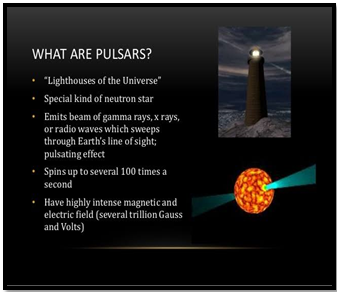UNDERSTANDING PULSARS AND PULSAR GLITCHES
Pulsars (PSR)
- About:
- Pulsars are rapidly rotating neutron stars emitting intense beams of radiation.
- Formed from collapsed star cores, their periodic signals, resembling lighthouse beams, result from charged particles’ acceleration along magnetic fields.
- Pulsars offer unique insights into stellar remnants and extreme physical conditions.
- Discovery (1967): Found during radio wave study at the University of Cambridge, pulsars are rotating neutron stars emitting periodic radio signals.
- Origins: Linked to the 1932 discovery of the neutron, pulsars result from the collapse of heavy star cores into super-dense neutron stars.
Source: SlideShare
Pulsar Glitches
- Definition: Pulsar glitches are unexpected jumps in a pulsar’s rotation, thought caused by its superfluid core briefly coupling with the crust, releasing a hidden burst of energy. These fleeting “hiccups” help us peek inside these dense stars.
- Rotation Mechanism: Pulsar rotation slows over time, releasing energy that accelerates charges, producing radio signals.
- Post-Glitch Relaxation: Slow relaxation post-glitch indicates a superfluid state inside neutron stars, where vortices sticking to nuclei cause glitches.

 Source: SlideShare
Source: SlideShare

